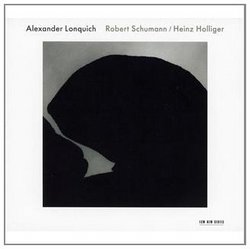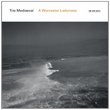| All Artists: Alexander Lonquich Title: Schumann/Holliger Members Wishing: 1 Total Copies: 0 Label: ECM Records Original Release Date: 1/1/2011 Re-Release Date: 3/15/2011 Genre: Classical Styles: Historical Periods, Classical (c.1770-1830) Number of Discs: 1 SwapaCD Credits: 1 UPC: 028947638261 |
Search - Alexander Lonquich :: Schumann/Holliger
 | Alexander Lonquich Schumann/Holliger Genre: Classical
"Schumann," says Heinz Holliger, "is the composer who has almost always been at the true center of my thoughts". On this recording, Alexander Lonquich makes plain the connections between their worlds, linking Kreisleriana'... more » |
Larger Image |
CD Details
Synopsis
Product Description
"Schumann," says Heinz Holliger, "is the composer who has almost always been at the true center of my thoughts". On this recording, Alexander Lonquich makes plain the connections between their worlds, linking Kreisleriana's dark, nocturnal romanticism with the "radicalised romanticism" of Holliger's Partita. A century and a half separates the two works. Lonquich plays the 1838 version of Kreisleriana and the Partita (composed in 1999), two works dedicated to great pianists, respectively Frédèric Chopin and Andràs Schiff, and conveys Holliger's vision of the language of Schumann extended into the present. "As the final echoes of Kreisleriana give way to the first movement of Heinz Holliger's Partita, our first reaction is one of amazement", writes Hans-Klaus Jungheinrich in the liner notes. "The prelude seems to be a direct continuation of the Schumann style, now hurled off track and channelled in directions which it enters as a matter of course, as if only a thin wall had kept its latent energies from exploding in full force. As might be expected, we soon notice that other forces and more rapid gesticulations are at work, that one and a half centuries of musical composition have prepared the ground for the compositional explosion here on display, sweeping aside all the hoary rules and props of musical academia." The core energies of the Partita, allying idiosyncratic imagination to great technical demands, are anticipated in Kreisleriana, whose "musical idiom is high-strung, impatient, constantly interrupted. This music is not so much firmly shaped and flowing as improvisatory - suddenly bursting forth, faltering, yet presented with the felicitous rapture of an exhilarating line of verse. The pianist Alexander Lonquich exposes himself mercilessly to the rough and tumble of Kreisleriana's romanticism." Lonquich's decision to work with the first version of Kreisleriana, rather than the better-known revised version of 1849 is explained by the pianist in a performer's note in the CD booklet. "Many passages in the original edition have far more extreme dynamic and agogic markings than we find twelve years later. Several ritardandos - hesitations that interrupt the natural flow, sometimes coming almost to a standstill - were later 'expunged'... To follow this system of tempos and contrasts is unavoidably to court an impression of inner disunity. Highly imaginative flights of fancy seemingly detached from their context are laboriously pieced together into a whole - an exact portrait of Schumann's psyche... To my mind, the 1849 version sacrificed many subtleties to the need for simplicity and clarity. The second piece is unquestionably more polished and well-rounded in the later version, but isn't there a special attraction to the fragility of the initial conception? And again, aren't the two editions almost identical? No, they aren't. When I play them I feel that those accents, those hesitations are without doubt formally constitutive. The original version really does tell us a completely different story."
Similar CDs
| Ketil Bjornstad, Svante Henryson Night Song Genres: Jazz, Pop Label: ECM Records | |
| Marcin Wasilewski Trio, Marcin Wasilewski, Slawomir Kurkiewicz Faithful Genres: Jazz, Pop Label: ECM Records | |
| Trio Mediaeval Worcester Ladymass Genre: Classical Label: ECM Records | |

 Track Listings (15) - Disc #1
Track Listings (15) - Disc #1

